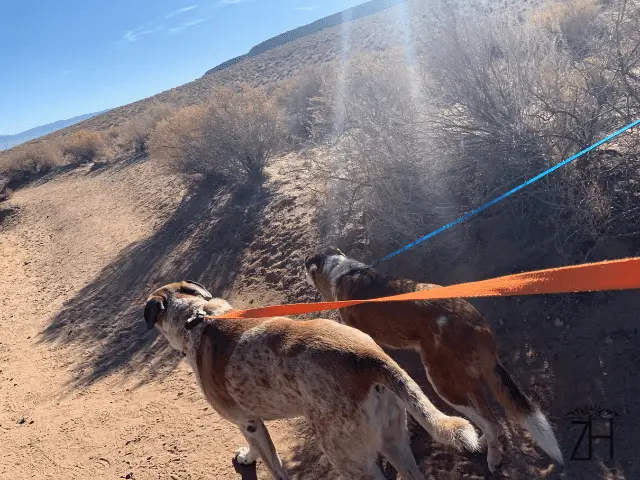Hiking comes with a myriad of physical and mental benefits, not only for you but also for your dog. It builds endurance, promotes cardiovascular health, and maintains muscle mass. More importantly, it provides you with the perfect chance to work on your pup’s training and good behavior!
Surrounded by new sights, smells, and sounds, hiking trails are one of the best places to train obedience and discipline. However, over-exercising is a serious issue for dogs. So, this begs the question: can dogs be sore from hiking?
Can Dogs Be Sore From Hiking?
Yes, dogs can get sore after hiking for too long. It’s especially common among dogs who aren’t used to exercise.
As with any mammal on Earth, prolonged or repetitive physical activity can overexert the muscles, thus leading to soreness.
For dogs, soreness is attributed to muscle pain and stiffness. In general, dogs experience muscle soreness several hours after the hike. When you arrive home, you might think they’re simply exhausted after the hike, but in truth, they may be feeling the effects of muscle strain.
Here are some physical signs that your dog is sore:
- Reluctance or inability to get up
- Struggling to walk up or down the stairs
- Whimpering when moving about
- Limping
- Tight or twitching muscles
- Holding head below the shoulders
- Restlessness
Factors That Contribute to Soreness in Dogs

Every dog is unique. Some dogs can hike up to 30 miles without breaking a sweat, while others refuse to take another step after 5. Here are some factors that may contribute to soreness in dogs after a hike.
Age
Naturally, young pups and senior dogs aren’t as physically healthy as dogs between the ages of 2 to 8.
The former two can’t spend as much time on their feet.
Young pups, with their developing bones and small lungs, won’t be able to keep up with your long strides and stamina.
Senior dogs have weaker joints and other health problems due to age, making them more susceptible to soreness after hiking.
Our Chompers is now 16 years old (yes, 16!) and still LOVES to hike although we have to be more careful with how often and how far we hike with her now.
Breed
Some breeds are naturally used to strenuous physical activities. They were bred for long hours of work in rough weather conditions. For this reason, they rarely feel sore even after walking long distances.
Brachycephalic breeds like Pugs, Shih Tzus, and Boxers, aren’t suited for long-distance walks because they have weaker muscles and weaker lungs.
Dogs with short legs are also more likely to become sore after long hikes. Since they don’t cover as much ground as long-legged dogs, they’re putting more effort to keep up with your strides. This puts more strain on their muscles, resulting in pain and soreness.
Hiking Experience

Dogs who aren’t used to hiking are more likely to become sore than dogs who hike every week.
Like humans, dogs need to train their muscles for long-distance walks to lessen the amount of soreness they experience.
With regular activity, dogs can surpass a human’s pace with no issues. It just takes a bit of time and practice.
Hiking Difficulty
Just like with us, the harder and longer the hike, the more likely your dog will become sore.
Hiking in elevated steeps through dense vegetation is far more challenging and exhausting than hiking in flat, easy-to-travel terrains. Likewise, hiking 5 miles is a walk in the park compared to hiking 15 miles.
This is why you should always consider your dog’s hiking experience and health before taking on big trails.
How Long Is Too Long for a Day Hike With Your Dog?
Seasoned hikers can easily cover 25 to 30 miles on a day hike, with their dogs covering more off-leash. Dogs who aren’t used to long-distance walks can happily hike around 5 to 10 miles without feeling sore as long as they’re healthy and fit.
Keep in mind that dogs don’t have as much stamina as humans, so they probably can’t keep up that pace for multiple days in a row. “Don’t be a weekend warrior,” says Dr. Jen Pascucci, animal therapist and veterinarian. “Fitting in a week’s worth of exercise on the weekend isn’t good for dogs who aren’t used to such activity.”
Some dogs are just happy to spend time with their owners and will do anything to keep up with their pace. Their drive to work and play may force them to push through fatigue and potential injury. This is why owners should take responsibility and place boundaries to limit their dog’s high drive.
To determine how long is “too long,” you’ll first have to look at your dog’s age, breed, experience, and overall health.
If you don’t quite know how far your dog can go, start with an acceptable pace of 3 to 5 miles before increasing it with half-mile intervals after every session.
Keep a close eye on his physical state and make sure he gets sufficient breaks every so often. It might take several weeks to months to reach your dog’s full hiking potential, so don’t rush it to prevent soreness, injury, and exhaustion.
How to Help a Dog With Sore Muscles

If your dog feels sore after a long hike, there are several things you can do to help him feel better.
- Apply a heating pad or ice pack on the affected area.
- Give your dog veterinarian-approved nonsteroidal anti-inflammatory drugs (NSAIDs) to reduce pain and inflammation.
- Gently massage the sore area.
- Soak your dog’s paws in warm water mixed with Epsom salts to ease soreness.
- Let your dog rest and put future activities on hold until they feel better.
- Let them drink lots of water to loosen their joints. Place the bowl within reach so they don’t have to walk too far to drink.
How to Reduce or Prevent Muscle Soreness After a Hike
Like cats, dogs don’t show their pain until it’s too late. It’s therefore your responsibility to stop them from pushing themselves too far. Prevention is better than cure, after all.
Here are some tips to reduce or prevent muscle soreness in dogs after a long hike.
- Don’t cram an entire month’s exercise in a few days. Gradually increase your hiking mileage so your dog doesn’t over-exert himself.
- Keep your dog well-hydrated throughout your hike. Carry at least 8 ounces of water for your dog per hour of hiking.
- Start with flat, easy-to-travel terrain and progressively increase the terrain difficulty per your dog’s experience.
- Take regular breaks to speed up muscle recovery. Ideally, you and your dog should stop for quick water and food break every hour or so.
- Don’t push your dog too far. If you notice them showing signs of exhaustion, give him time to recover and rest. You might also want to stop the hike and go back home.
- Let your dog physically recover after hiking. Don’t take them hiking two days in a row.
- Alternate between short and long-distance hikes throughout the week.
Final Thoughts
Like humans, dogs may experience soreness after partaking in intense physical activities.
Soreness occurs as a result of overexertion and exercise. When a dog exerts more effort beyond what he or she is accustomed to, they’ll definitely feel the consequence in their muscles and bones.
Hiking can be quite grueling to dogs who aren’t used to long-distance walks. Therefore, it’s your responsibility to make sure they’re not pushing themselves too hard on your hikes. Keep a close eye on any physical signs of discomfort and stop the hike immediately if he begins to show fatigue.
Good luck and happy hiking!
